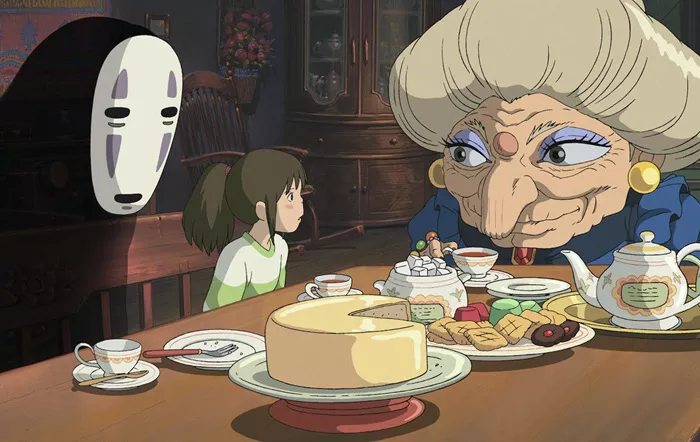Spirited Away,” directed by Hayao Miyazaki and produced by Studio Ghibli, is widely regarded as one of the greatest animated films ever made. Since its release in 2001, the film has captivated audiences around the world with its enchanting story, complex characters, and breathtaking animation. This article explores the intricate process behind the creation of “Spirited Away”, detailing the time, effort, and creativity required to bring this extraordinary film to life.
Pre-production: Conceiving a World
Initial Concept and Development
The journey of “Spirited Away” began with Hayao Miyazaki’s idea to create a film for ten-year-old girls, which would encapsulate the whimsical and adventurous spirit of youth. The initial concept was inspired by the daughter of a friend, giving rise to the story of Chihiro Ogino’s transformation from a sullen, disinterested girl to a capable and courageous heroine. Miyazaki started the project without a formal script, a common practice for him, allowing the story and characters to evolve organically during production.
Storyboarding: The Blueprint of Animation
Hayao Miyazaki, known for his hands-on approach, personally drafted the storyboards that would become the foundation of “Spirited Away.” This process took approximately four months, during which Miyazaki meticulously outlined every scene, ensuring that the narrative flow and visual style were perfectly aligned. The storyboarding phase is critical in animation, as it dictates the pacing of the film and the interaction between characters and settings.
Production: Bringing the Vision to Life
Character Design and Development
Designing the film’s characters was an iterative process, with Miyazaki and his team spending considerable time ensuring each character’s appearance and personality were finely tuned to reflect their roles in the story. From the enigmatic Haku to the greedy witch Yubaba, each character was crafted to resonate deeply with the audience. This phase of character development was crucial for the film’s emotional depth and thematic complexity.
Art and Setting Creation
The world of “Spirited Away” is known for its lush, detailed environments, which draw heavily from Japanese folklore and mythology. The bathhouse, where much of the film takes place, was inspired by the historic Edo-Tokyo, with elements borrowed from various Japanese hot spring inns. The art team, led by art director Youji Takeshige, spent over a year designing these intricate settings, which not only serve as a backdrop for the action but also enhance the film’s mood and help advance the story.
Animation: The Heartbeat of Studio Ghibli
Animating “Spirited Away” was a labor-intensive endeavor that involved over 100 animators and artists. Each frame was hand-drawn and painted, adhering to Studio Ghibli’s high standards for artistic excellence. The animation process took nearly two years, with artists working painstakingly to ensure that every movement conveyed the right emotions and every scene was visually stunning.
Post-production: Final Touches
Editing and Compositing
Once animation was complete, the film underwent editing to ensure seamless transitions and pacing that matched Miyazaki’s vision. Compositing followed, where the numerous layers of animation, backgrounds, and effects were painstakingly integrated to create the final scenes.
Music and Sound Design
Joe Hisaishi, a long-time collaborator with Miyazaki, composed the film’s iconic score, which plays a crucial role in building the emotional landscape of “Spirited Away.” The music was composed concurrently with the production so that it could be perfectly synchronized with the visual elements. Sound design was also critical, adding a layer of realism and depth to the animated world.
Challenges Along the Way
Technical and Creative Hurdles
Creating a film as ambitious as “Spirited Away” was not without its challenges. The team faced numerous technical difficulties, especially in scenes involving complex water animation and intricate crowd scenes. Additionally, Miyazaki’s decision to work without a completed script meant that adjustments were frequently made on the fly, demanding flexibility and creativity from the entire team.
Cultural and Philosophical Depth
Ensuring that the film’s themes and cultural references resonated with both Japanese and international audiences presented another layer of complexity. Miyazaki’s films are known for their deep philosophical undertones, and “Spirited Away” is no exception, exploring themes of identity, greed, and environmentalism.
Conclusion: A Timeless Contribution to Cinema
From inception to completion, “Spirited Away” took approximately three years to create, with the production phase alone lasting from 1999 to 2001. This period of intense, dedicated craftsmanship highlights not only the challenges faced by the creators but also their unyielding commitment to artistry and storytelling. “Spirited Away” remains a pinnacle of animation, not only for its technical achievements but for its profound impact on viewers around the world. As it continues to inspire and enchant new generations, the legacy of Miyazaki’s work is a testament to the enduring power of meticulous and passionate creative expression.

